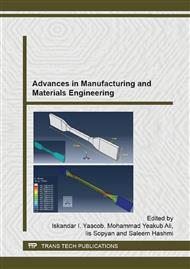[1]
N. Sridhar, and D. Hill, in: CO2Utilization (Electrochem. Conversion of CO2, Opportuinities and Challenges DNV report. 07, (2011), pp.1-18.
Google Scholar
[2]
E. Olsen, in: CO2 Captured in Molten Salts, US Patent 0128559, A1, (2012), pp.1-4.
Google Scholar
[3]
H. Yin, M. Xuhui, T. Diyong, X. Wei, X. Luru, Z. Hua, W. Dihua, and D.R. Sadoway: submitted to J. Energy & Environ. Sci., 6(5), (2013), pp.1538-1545.
Google Scholar
[4]
O.S. Ryosuke, O. Koya, O. Takuya, K. Hiroshi, and K. Tatsuya: submitted to J. Electrochem. Soc. 50(11), (2013), pp.443-450.
Google Scholar
[5]
T. Diyong, H. Yin, X. Mao, W. Xiao and D.H. Wang: submitted to J. Electrochimica Acta, 114, (2013), pp.567-573.
Google Scholar
[6]
S. Licth, S. Stabilisation of STEP electrolyses in Lithium-Free Molten Carbonate. (2012) Available from: http: /arxiv. org/ftp/arxiv/papers/1209/1209. 3512. pdf.
Google Scholar
[7]
H. Kawamura, and Y. Ito: submitted to App. Electrochem., 30, (2000), pp.571-574.
Google Scholar
[8]
J.S. Nancy, in Electro. of Molten Carbonate Salt & Its Applic., of PhD Thesis, UoN (2011).
Google Scholar
[9]
S. Licht, W. Baohui, G. Susanta, A. Hina, J. Dianlu, and G. Jason: submitted Phys. Chem. Letters, 1, (2010), pp.2363-2368.
Google Scholar
[10]
S. Licht, C. Baochen, and W. Baohui, STEP Carbon Capture, The Barium Advantage CO2 Utilization, 2, (2013) pp.58-63.
DOI: 10.1016/j.jcou.2013.03.006
Google Scholar
[11]
M.D. Ingram, B. Baron and G.J. Janz: submitted to Electrochim. Acta, 11, (1966), pp.1629-1639.
Google Scholar
[12]
L. Massot, P. Chamelot, F. Bouyer and P. Taxil: submitted to Electrochim. Acta, 47, (2002), p.1949-(1957).
Google Scholar
[13]
B. Kaplan, H. Groult, A. Barhoun, F. Lantelme, T. Nakajima, V. Gupta, S. Komaba and N. Kumagaic: submitted to J. Electrochem. Soc., 149(5), (2002), D72-D78.
DOI: 10.1149/1.1464884
Google Scholar
[14]
Y. Ito, H. Kawamura, in: The Electrochem. Soc. Proceedings, Edited by R.J. Gale, C. Blomgren and H. Kojima, Vol. PV92-16 of The 8th Inter. Symp. Molten Salts, NJ, (1992), p.574.
Google Scholar
[15]
Y.K. Delimarskii, V.I. Shapoval, V.A. Vasilenko and V.F. Grishchenko: submitted to Zhurnal Prikladnoi Khimii (Sankt-Peterburg, Russian Federation), 43(12), (1970), pp.2634-2638.
Google Scholar
[16]
P.K. Lorenz and G.J. Janz: submitted to Electrochim. Acta, 15, (1970), pp.1025-1035.
Google Scholar
[17]
B. Marinho, G. Marcos, T. Evgeniy, E.K. Cor, and D.W. Gijsbertus: submitted to Powder Tech., 221, (2012), pp.351-358.
Google Scholar
[18]
H.V. Ijije, C. Sun, and G.Z. Shen: submitted to Carbon, 73, (2014), pp.163-174.
Google Scholar
[19]
U.S. Depart. of Energy, in U. S Energy Requirements for Al Production, Historical Perspective Theoritial Limits and Current Practice, (2007).
Google Scholar


